

What is the minimum viable product? Eric Ries and I recently sat down to talk about minimum viable products: the product with just the necessary features to get money and feedback from early adopters.
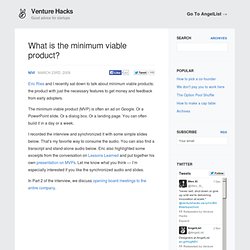
The minimum viable product (MVP) is often an ad on Google. Monitor110: A Post Mortem. Turning Failure into Learning Writing a post mortem is hard, particularly when the result is failure: a failed deal; a failed investment; a failed concept.
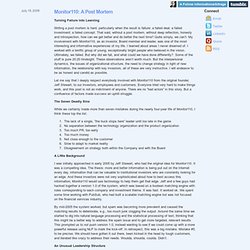
That said, without a post mortem, without deep reflection, honesty and introspection, how can we get better and do better the next time? Quite simply, we can’t. My involvement with Monitor110, as an investor, Board member and leader, was one of the most interesting and informative experiences of my life. I learned about areas I never dreamed of. Let me say that I deeply respect everybody involved with Monitor110 from the original founder, Jeff Stewart, to our investors, employees and customers.
The Seven Deadly Sins While we certainly made more than seven mistakes during the nearly four-year life of Monitor110, I think these top the list. Lessons from our failed startup / OliveScreens. Three Rivers Institute » Blog Archive » Approaching a Minimum Viable Product. The purpose of the MVP is to answer your most pressing question or validate your most pressing business assumption.
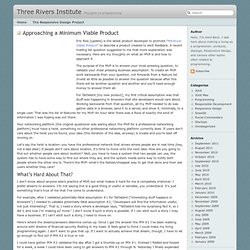
Work backwards from question, not forwards from a feature list. For Tattlebird, my most critical assumption was that stuff was happening in browsers that site developers would care about. Working backwards from that I needed to gather the data in the browser, send it to a server, and show it, minimally, to a single user. That was the list of features for my MVP. Nothing happened in the first few minutes so I was ready to move on. Your networking platform must have a twist, something no other professional networking platform currently does. Let’s say the twist is location–you have the professional network that shows where people are in real time (hey, not a bad idea!) That’s how I practice MVP, in any case. Eric Ries [update] is the latest product developer to promote “Minimum Viable Product” to describe a product created to elicit feedback. Post Mortem on a Failed Product. Just over two years ago, at the beginning of 2008, we set out to build a web content management system with community functionality infused throughout — eCrowds.

The idea was that companies would need a solution for facilitating product communities with the following functionality: Content managementForumsBlogsIdea exchangesWikis We were solving the traditional challenges brought on by disparate silos of data with separate user authentication systems and inconsistent interfaces/template designs. 2008 was spent building the product and we launched it for our own internal customer success communities after nine months of development. Minimum Viable Product: a guide. One of the most important lean startup techniques is called the minimum viable product.
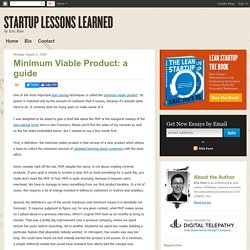
Its power is matched only by the amount of confusion that it causes, because it's actually quite hard to do. It certainly took me many years to make sense of it. I was delighted to be asked to give a brief talk about the MVP at the inaugural meetup of the lean startup circle here in San Francisco. Below you'll find the video of my remarks as well as the full slides embedded below. Ten Rules for Web Startups. #1: Be NarrowFocus on the smallest possible problem you could solve that would potentially be useful.
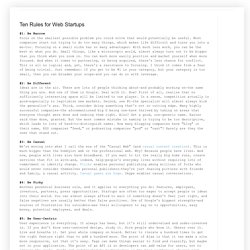
Most companies start out trying to do too many things, which makes life difficult and turns you into a me-too. Focusing on a small niche has so many advantages: With much less work, you can be the best at what you do. Small things, like a microscopic world, almost always turn out to be bigger than you think when you zoom in. You can much more easily position and market yourself when more focused. And when it comes to partnering, or being acquired, there's less chance for conflict. . #2: Be DifferentIdeas are in the air. . #3: Be CasualWe're moving into what I call the era of the "Casual Web" (and casual content creation) . #4: Be PickyAnother perennial business rule, and it applies to everything you do: features, employees, investors, partners, press opportunities. Minimum Viable Product rant. Lately, you can’t swing a dead cat at a gathering of Internet entrepreneurs without hitting someone in mid-sentence talking about their “minimum viable product.” The problem is that half the time, I don’t hear them talking about minimum viable products.
Communicating with code. Some people can sell their ideas with a brilliant speech or a slick powerpoint presentation. I can't. Maybe that's why I'm skeptical of ideas that are sold via brilliant speeches and slick powerpoints. Or maybe it's because it's too easy to overlook the messy details, or to get caught up in details that seem very important, but aren't. I also get very bored by endless debate. We did a lot of things wrong during the 2.5 years of pre-launch Gmail development, but one thing we did very right was to always have live code. The great thing about this process was that I didn't need to sell anyone on my ideas. The most dramatic example of this process was the creation of content targeted ads (now known as "AdSense", or maybe "AdSense for Content"). However, we needed a way for Gmail to make money, and Sanjeev Singh kept talking about using relevant ads, even though it was obviously a "bad idea".
More importantly, I wasn't the only one who found the ads surprisingly relevant.